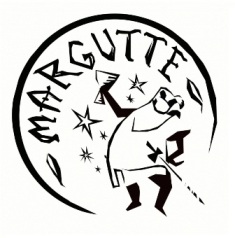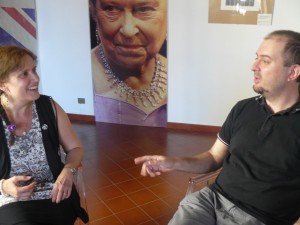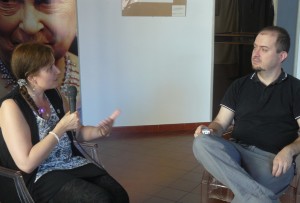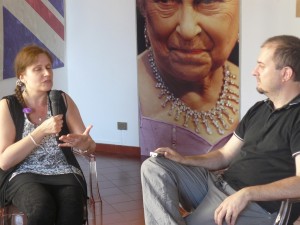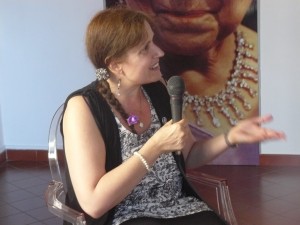INTERVIEW BY LORENZO BARBERIS / ITALIAN TRANSLATION BY SILVIA PIO.
Margutte: You have chosen wood engraving as your main form of artistic expression, why?
Anne Desmet: I’ve always been very interested in drawing in black and white, so at school I drew in black ink and when I went to university I was introduced to print making. Wood engraving attracted me particularly because you are engraving light out of darkness.
Take a block before you engrave it, if you were to ink it and print it you would have a black square printed on your piece of paper. The marks that you engrave are the white areas of the image. And I find something very beautiful psychologically about this idea of creating a light image out of darkness, bringing an image to light, to life that way.
M.: In your work there is important reference to Renaissance art. How do you relate with the Renaissance tradition of printing and engraving, of which Mondovì hosted some important examples?
A.D.: I’ve always been very interested in historical paintings, from Italy and Belgium primarily. I am half Belgian, my father was Belgian and I spent a lot of time in Belgium in my childhood on family holiday. When I was there I became very interested in the works of Van Eyck, Memling and others. Later I had a scholarship to Rome for a year, twenty-four years ago now, and I had already looked in books at the works of Giotto, Masaccio, Piero della Francesca and many more. There is something in the intensity of vision about those artists’ work that I like, a sense of making art that maybe is not on a very large scale but suggests a huge vista of space and a whole enclosed world all of its own.
Bruegel’s Tower of Babel suggests something absolutely immense and yet his paintings are not very large. The sense of detail and the sense of space in those paintings is … fantastic. The same with the tiny Van Eyck’s for instance; in London in the National Gallery we have the Arnolfini Marriage by Van Eyck, which is a small intimate painting but suggests a whole sense of space beyond the room that you are looking at, which in a way is maybe what I like to do with wood engraving. Often the wood engravings are very small scale but I hope that they suggest larger worlds and views beyond what you can actually see. And the same is true with Giotto and Piero della Francesca and some of their frescoes. They are not such large works yet they do set up a sense of timelessness and of space. And the stillness I find very attractive, I look at them a great deal.
M.: Your works show that you are particularly interested in architecture, both modern and classical. What are the reasons of this choice?
A.D.: I was never particularly interested in architecture at school or even at university, which is perhaps a bit depriving because I did my Fine Art degree at Oxford university, a very beautiful city with very beautiful College buildings. I think it was certainly my scholarship to Rome in 1989 that made me interested in architecture. Partly because of the huge sense of history and the sense of thousands of years of layers of human history that is built into the architecture of Rome. And also the way light in Italy is so different from in Britain and the way the light makes a building look so absolutely three dimensional. Of course the building is three dimensional but Britain has a much flatter light, so the structure of the buildings is not so pronounced. And for me as an engraver, working in light and dark, those strong rather theatrical contrasts became very important and it was living and working in Rome that gave me that inspiration.
As well as that, I had had for years an interest in metamorphosis and transformation. Very many of my works from College day were inspired by what I read, and I read a lot of Latin, Ovid’s Metamorphosis and Virgil’s Aeneid. I liked those stories of transformation and change in Ovid’s Metamorphosis and it seemed to me that in Rome I had square in front of me a whole sense of metamorphosis and change in human history, going on before my eyes in the form of the architecture. That has continued to be an inspiration for me ever since.
M.: The Tower of Babel and its meanings seem to be important in your works, why?
A.D.: My interest in the Tower of Babel has a reason really out of my interest in Italian architecture rather than so much from the Bible. In the Bible there is a very small reference to the Tower of Babel, just one or two verses talk about this tower being built and then destroyed because God’s confounding the languages of the builders. It’s an interesting idea, that very many artists, as I mentioned before, Bruegel and many others, have dealt with over the years. I came to find it interesting really through the sense of layering in architecture. It’s what you see in Rome, where there’s an ancient piece of Roman architecture and on top of that maybe there’s a Medieval church and on top of that something Baroque and on top of that something else again. That idea of building layers and layers and forming in effect towers. There’s a certain chaos to that, a beautiful chaos as well as a strange sense of order.
To me the idea of the Tower of Babel is also an idea of human aspiration; it may be a flawed aspiration, wanting to make something magical that reached to heaven, in the same way that you have had towers here in this country for many years. I go to places like Bologna and San Giminiano and see towers, some of which have survived some of which have half collapsed. Rival families wanted to build one tower taller than another, and there’s aspiration in that; a desire to impress is not always the most lofty of aspirations, sometimes the motive may not be good but other times you feels that people have had a dream when they built towers, which I think is still true today. The most modern architecture, as the Shard in London, the brand new tall buildings in the Arab world, share this sense of aspiration, wanting to build these wonderful structures that nobody had seen the like of before.
It’s rather a complicated lot of thoughts, but to me the idea of the Tower of Babel is a sort of symbol of human ambition, I hope the best of human ambitions although they don’t always work out as one might hope.
M.: Nowadays technology is deeply changing printing tradition, maybe it is ending the printing as we know it. What does this entail in wood engraving?
A.D.: In Britain there are rather few engravers now, maybe a hundred, and there is only one man who makes the blocks that are used by all wood engravers, while a century ago there would be hundreds of hundreds of engravers and illustration firms that employed many engravers. So in that sense you might look at it and think: is it an old fashioned skill, is it dying, is there anybody who’s doing it?
But I think there is another sign to it where artists like myself and also like Simon (Brett) have taken wood engraving into the fine art world and used it as a medium to express ideas that can be exhibited on the walls of galleries as well as be wonderful as illustrations, and can also exist as independent works of art.
The world of art tends to work in cycles, things become out of fashion then come back into fashion. I think there has been a long period where wood engraving and figurative art generally, certainly in Britain, have been unfashionable but I do think that is changing again and that there is a renaissance of interest in these craft skills. And perhaps with exhibitions like this and others, that sort of interest is being regenerated in the visitors that see such exhibitions. There are always people who want to learn how to do a technique associated to an art, so I’m quite positive about the future of wood engraving.
In terms of new technology I think it is a shame when new technology seems to overtake the old so that the old is not used anymore. I think the new technology can simply add to a broadening of media available for artists. I think that all the technology which is available may expand the repertoire of what one can make as an artist.
Interview by Lorenzo Barberis
Italian translation by Silvia Pio
Photos by Roxy Columbus.
.
